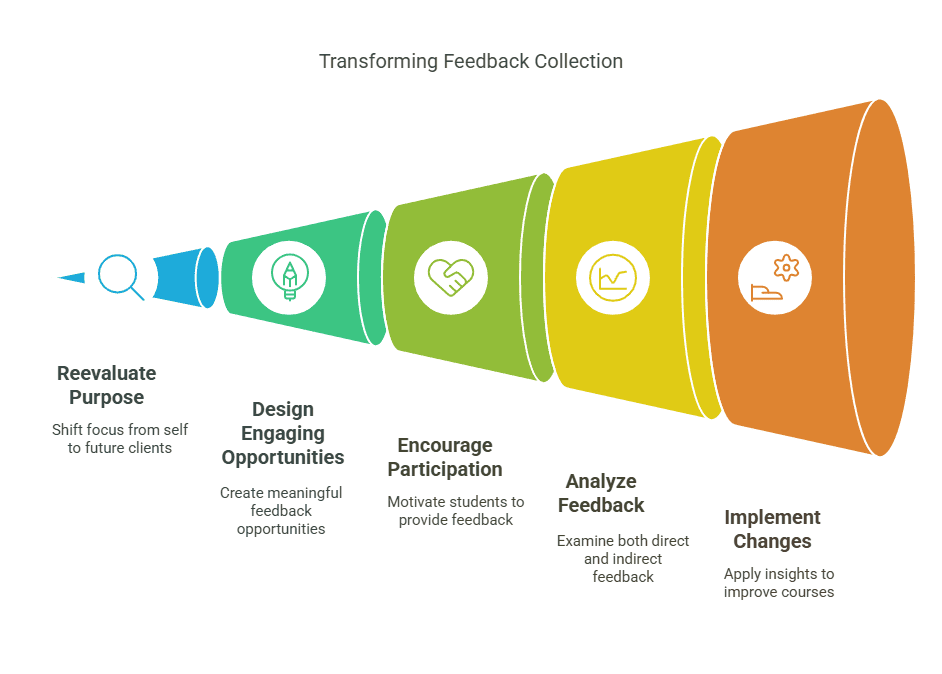
"Why is no-one filling out my feedback form?"
I do not doubt that you know what the feedback process is, why feedback is so valuable to collect, and, to some extent, how to collect feedback in your online course.
Yet, why is it still so difficult to receive constructive feedback?
There are two factors in play here:
- Students not providing feedback
- Course creators not providing opportunities to collect feedback
So, how can you encourage the collection of feedback?
You know the what, why and how; but what about the who?
- You as the course creator?
- You as an entrepreneur?
- You as a small business owner?
- You as a CEO of an agency?
Are you showing vulnerability when collecting feedback?
When collecting feedback are you open to hearing negative, soul-crushing feedback? Or are you afraid to hear this feedback?
Is that fear driving you to simply add on a feedback form at the end of your course? Feeling like you have ticked the box “add a feedback form.” Only to be left thinking, “why is no one filling out the feedback form!?”
Firstly, not everyone will get to the end of the course and as a result, not see the feedback form. Regardless if they want to provide excellent feedback or great constructive feedback. If they don’t see the avenue to provide feedback the opportunity is lost.
Secondly, you now need to motivate people to complete the form. The course is over, what is in it for them?
There are two types of people who will be motivated to complete the form. People who enjoyed your service or those that were disgruntled. Both will be driven to some extent on providing feedback, especially if a refund is on the table.
By simply adding the feedback form to the end of your course, feeling like you have ticked a box in your course creation journey, is an opportunity lost for great constructive feedback
So, when can you collect feedback?
Collect feedback consistently throughout the lifespan of your course, ensuring it is simple and short to complete.
An example of consistent feedback, without overwhelming your students, is constant check-ins, such as the following sequence:
Start your course with a “set your intentions” survey discovering:
What your clients want to achieve
Why they are in your course
What they want to get from your course
Throughout the course, launch check-in sequences asking:
How confident are you feeling about [insert their goal]
What additional support are you seeking
Reflection activity towards the end of your course (but not the final activity), with questions such as:
How confident are you with [insert goal]
What supported you the most
What would you have done differently
Setting these up as reflection activities shifts the motivation and places the responsibility and accountability on your students, while you can receive honest feedback.
However, proactively seeking direct feedback is not the only method. You can also gather indirect feedback.
Are you collecting indirect feedback?
Indirect feedback is when your clients provide you feedback without you actively seeking it. I am not referring to unsolicited feedback (positive nor negative), I am referring to you listening for opportunities for constructive feedback.
For example, I recently delivered a workshop to my peers where I demonstrated a step by step process for effectively planning online courses to save time in the future. You can read the 3 steps to planning an online course here.
In the workshop, I drew the linear process with many arrows demonstrating how you can map content types to your course plan. A question raised by the audience made me realise that the diagram could be perceived differently.
Vulnerably accepting this clarifying question and listening for constructive feedback supported me to adapt future sessions accordingly.
Have you ever caught yourself listening to a question and immediately thinking “Wait, we have gone through this already, why don’t you know this?”
This is a perfect indicator that you are receiving indirect feedback.
Rather than thinking, “why do you not know the answer” ask yourself “how can I improve my content so this question is answered before it is asked?”
The question I have for you is, are you vulnerably listening to the indirect feedback you receive? Do you reflect on the questions you hear and identify how you can improve the coherence of your course content so you can avoid the same question arising in the future?
Other examples of indirect feedback are the data you can collect from your Learning Management System (LMS) such as quiz responses, short answer responses (verbal or written), views of a video, and completed lessons. Check out this video for other examples of indirect feedback.
If students are not progressing through your course content, why? Sometimes it could be as simple as a broken link! But if you are not listening for this data, how can you collect this feedback?

Tying it together
When you find ourselves thinking, 'no one is filling out my feedback forms', ask yourself:
Am I just adding a feedback form to the end of my course?
For whom do I collect feedback?
What type of feedback am I actively seeking?
Am I being vulnerable to hearing constructive feedback, and that fear hinders the feedback process?
How often am I collecting feedback?
Am I seeking opportunities for indirect feedback?
Remember, the feedback you collect is to understand how you can better support your future clients.
Ready to create your online course?
I guide my clients through designing, creating and launching their online courses to help them reduce the stress of course creation overwhelm!



